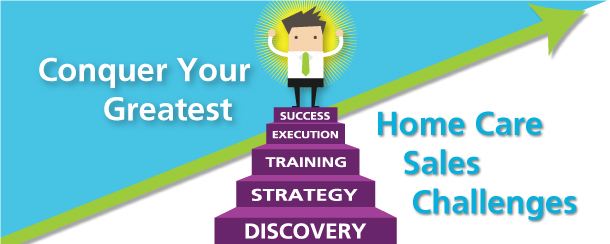
Achieving steady home care sales numbers or growing those numbers is often the trickiest and most stressful aspect of owning a home care company. Even top notch salespeople aren’t immune to the many challenges present in the home care industry. No matter how skilled you are or how practiced your pitch is, home care sales is the most competitive it has ever been. Sales challenges often follow shifts in the home care industry and require adjustments to your selling technique.
Have you or members of your home care sales team ever asked any of the following questions?
- How do I create a strategic selling plan?
- What new referral relationships should I develop?
- How do I grow existing referral relationships?
- What is the best way to sell the solutions my agency creates?
- How do I get past the gatekeeper?
- How do I adapt my selling style to another’s buying style?
- What is the best way to track, measure, and show results from my home care sales efforts?
Not knowing how to answer these and other questions can stifle your sales productivity and limit your overall results. But there’s great news: These challenges can be overcome with the right training and strategies.
Finding Your Sales Direction
An oft-quoted paraphrase from Lewis Carroll’s Alice in Wonderland suggests, “If you don’t know where you are going, any road will get you there.” This is very true when it comes to home care sales; without direction, you’ll find yourself wandering down any old path, maybe the wrong one altogether.
“Wandering” can manifest itself in many ways for home care salespeople. You may find that your days are filled with making cold calls, attempting to track down referral sources, setting up meetings that constantly get rescheduled, and basically just keeping your head above water. If this sounds all too familiar, it’s time for a strategic plan that evaluates the strength of current referral sources and identifies market opportunities for new ones. Setting up these strategies ensures that a) you’re not wasting time, money, and resources on referral targets that aren’t referring to you, and b) you’re continuing to focus on new opportunities with potential sources.
With that in place, you then need to identify the real and value-driven solutions your agency creates for current and potential referral partners. In home care sales, it’s vital to create mutually beneficial partnerships with your referral sources. Obviously, your agency benefits from the referrals they send your way, but what do you bring to the table? How can your agency be a helpful or useful partner? How do you measure your value and communicate it to others?
Finally, you need to approach each person with a selling style that adapts to his or her buying/communication style. Every person you encounter in both your personal life and your business life is unique and communicates in a unique way. This means that, while one person might respond positively to sitting down to a long lunch to discuss your personal lives and how they can partner with your agency, another person might find this type of interaction intrusive and a waste of time. Always remember, the sender is responsible for the message. If you want a message to be received, you have to understand how your target best receives messages.
Learning to hone in on your referral source’s buying style and adjust your selling style accordingly is a valuable skill that can return promising results.
Contact corecubed to learn more about how to market a home care agency with our sales training solutions.
